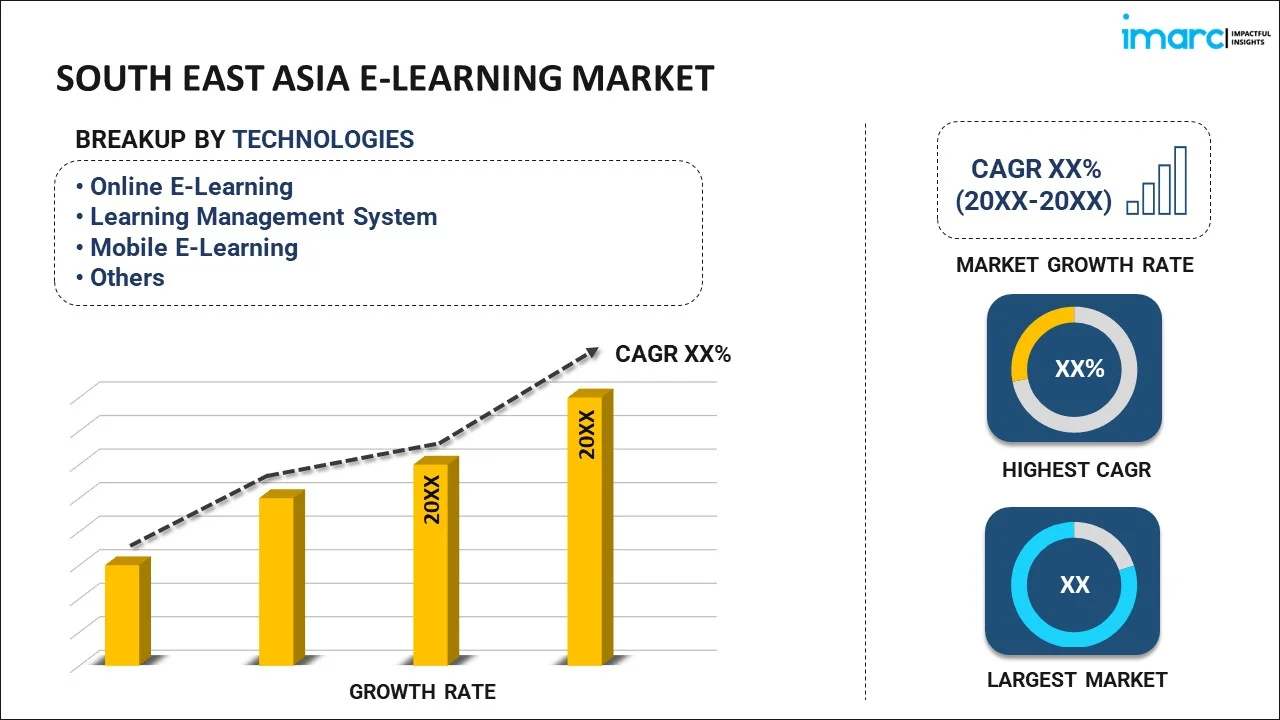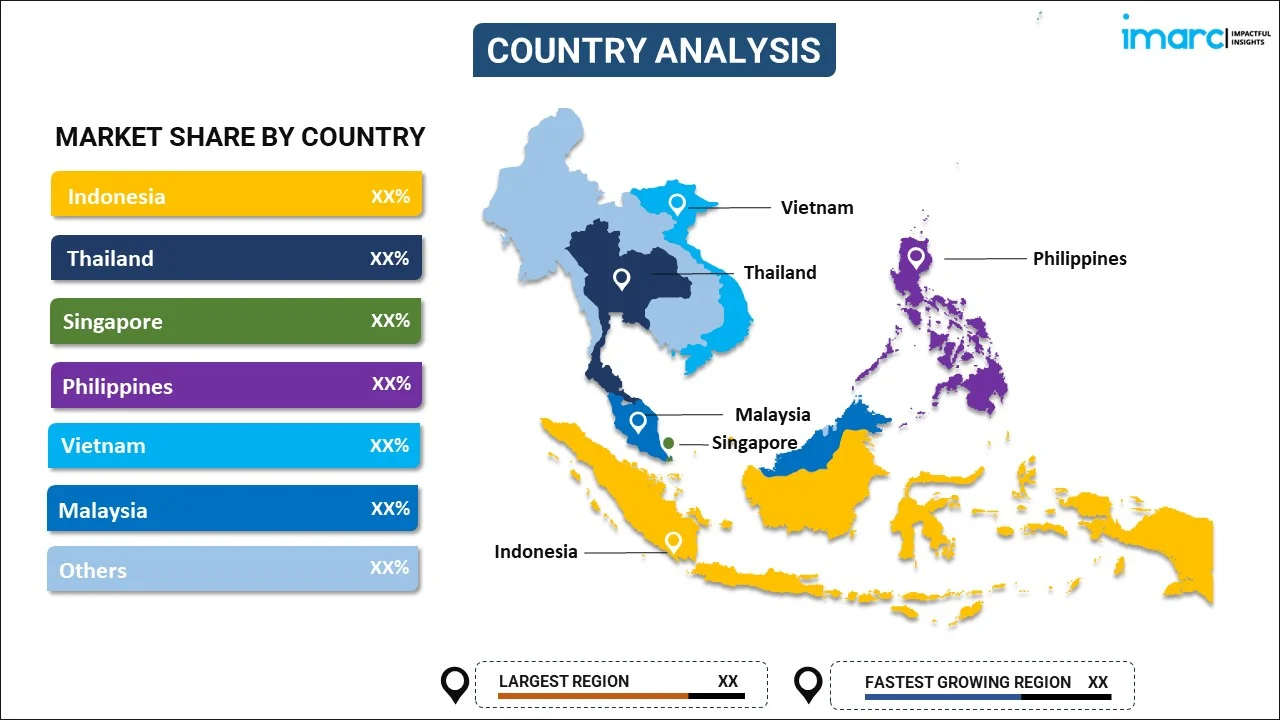
South East Asia E-Learning Market Report by Technology (Online E-Learning, Learning Management System, Mobile E-Learning, Rapid E-Learning, Virtual Classroom, and Others), Provider (Services, Content), Application (Academic, Corporate, Government), and Country 2025-2033
Market Overview:
South East Asia e-learning market size is projected to exhibit a growth rate (CAGR) of 15.11% during 2025-2033. The increasing advances in technology, particularly in internet connectivity, mobile devices, and learning management systems, which have made e-learning more accessible and user-friendly, are driving the market.
|
Report Attribute
|
Key Statistics
|
|---|---|
|
Base Year
|
2024 |
|
Forecast Years
|
2025-2033
|
|
Historical Years
|
2019-2024
|
| Market Growth Rate (2025-2033) | 15.11% |
E-learning, or electronic learning, refers to the use of digital technologies to facilitate educational activities and deliver instructional content. It encompasses a broad range of online tools, platforms, and resources that enable learning outside traditional classrooms. E-learning can take various forms, such as online courses, virtual classrooms, interactive modules, and multimedia presentations. Learners can access educational materials anytime, anywhere, fostering flexibility and self-paced learning. This approach leverages the internet and digital devices to provide a dynamic and interactive learning experience, often including multimedia elements like videos, quizzes, and discussion forums. E-learning is especially relevant in the modern era, offering accessibility and scalability to diverse audiences. It has become a cornerstone of education, supporting formal academic courses, professional development, and lifelong learning initiatives.
South East Asia E-Learning Market Trends:
The e-learning market in South East Asia has witnessed unprecedented growth in recent years, fueled by several key drivers. Firstly, the widespread adoption of digital technology and ubiquitous internet connectivity have created an environment conducive to online education. As a result, learners in South East Asia can access educational resources and courses with ease, breaking down regional barriers. Moreover, the increasing demand for flexible learning solutions has driven the surge in e-learning platforms. Individuals and organizations alike seek the convenience of learning at their own pace, anytime and anywhere. This shift in preference towards on-the-go education has propelled the e-learning market forward, with platforms offering diverse courses and specialized content to cater to varied learning needs. Furthermore, the inflating adoption of e-learning as educational institutions and corporate entities swiftly embrace online learning solutions to ensure continuity in education and skill development, is also creating a positive outlook for the market. In conclusion, the confluence of technological advancements, growing demand for flexibility, and the impact of regional events have propelled the e-learning market forward in South East Asia, making it a dynamic and thriving sector poised for continued expansion.
South East Asia E-Learning Market Segmentation:
IMARC Group provides an analysis of the key trends in each segment of the market, along with forecasts at the regional and country levels for 2025-2033. Our report has categorized the market based on technology, provider, and application.
Technology Insights:

- Online E-Learning
- Learning Management System
- Mobile E-Learning
- Rapid E-Learning
- Virtual Classroom
- Others
The report has provided a detailed breakup and analysis of the market based on the technology. This includes online e-learning, learning management system, mobile e-learning, rapid e-learning, virtual classroom, and others.
Provider Insights:
- Services
- Content
A detailed breakup and analysis of the market based on the provider have also been provided in the report. This includes services and content.
Application Insights:
- Academic
- K-12
- Higher Education
- Vocational Training
- Corporate
- Small and Medium Enterprises
- Large Enterprises
- Government
The report has provided a detailed breakup and analysis of the market based on the application. This includes academic (K-12, higher education, and vocational training), corporate (small and medium enterprises and large enterprises), and government.
Country Insights:

- Indonesia
- Thailand
- Singapore
- Philippines
- Vietnam
- Malaysia
- Others
The report has also provided a comprehensive analysis of all the major regional markets, which include Indonesia, Thailand, Singapore, Philippines, Vietnam, Malaysia, and Others.
Competitive Landscape:
The market research report has also provided a comprehensive analysis of the competitive landscape in the market. Competitive analysis such as market structure, key player positioning, top winning strategies, competitive dashboard, and company evaluation quadrant has been covered in the report. Also, detailed profiles of all major companies have been provided. Some of the key players include:
- imc AG
- Quipper
- Three Learning Pte Ltd.
- Verztec Consulting Pte Ltd.
- Wizlearn Technologies
(Please note that this is only a partial list of the key players, and the complete list is provided in the report.)
South East Asia E-Learning Market Report Coverage:
| Report Features | Details |
|---|---|
| Base Year of the Analysis | 2024 |
| Historical Period | 2019-2024 |
| Forecast Period | 2025-2033 |
| Units | Million USD |
| Scope of the Report | Exploration of Historical and Forecast Trends, Industry Catalysts and Challenges, Segment-Wise Historical and Predictive Market Assessment:
|
| Technologies Covered | Online E-Learning, Learning Management System, Mobile E-Learning, Rapid E-Learning, Virtual Classroom, Others |
| Providers Covered | Services, Content |
| Applications Covered |
|
| Countries Covered | Indonesia, Thailand, Singapore, Philippines, Vietnam, Malaysia, Others |
| Companies Covered | imc AG, Quipper, Three Learning Pte Ltd., Verztec Consulting Pte Ltd., Wizlearn Technologies, etc. |
| Customization Scope | 10% Free Customization |
| Post-Sale Analyst Support | 10-12 Weeks |
| Delivery Format | PDF and Excel through Email (We can also provide the editable version of the report in PPT/Word format on special request) |
Key Questions Answered in This Report:
- How has the South East Asia e-learning market performed so far and how will it perform in the coming years?
- What has been the impact of COVID-19 on the South East Asia e-learning market?
- What is the breakup of the South East Asia e-learning market on the basis of technology?
- What is the breakup of the South East Asia e-learning market on the basis of provider?
- What is the breakup of the South East Asia e-learning market on the basis of application?
- What are the various stages in the value chain of the South East Asia e-learning market?
- What are the key driving factors and challenges in South East Asia e-learning?
- What is the structure of the South East Asia e-learning market and who are the key players?
- What is the degree of competition in the South East Asia e-learning market?
Key Benefits for Stakeholders:
- IMARC’s industry report offers a comprehensive quantitative analysis of various market segments, historical and current market trends, market forecasts, and dynamics of the South East Asia e-learning market from 2019-2033.
- This research report provides the latest information on the market drivers, challenges, and opportunities in the South East Asia e-learning market.
- Porter's five forces analysis assist stakeholders in assessing the impact of new entrants, competitive rivalry, supplier power, buyer power, and the threat of substitution. It helps stakeholders to analyze the level of competition within the South East Asia e-learning industry and its attractiveness.
- A competitive landscape allows stakeholders to understand their competitive environment and provides an insight into the current positions of key players in the market.
Need more help?
- Speak to our experienced analysts for insights on the current market scenarios.
- Include additional segments and countries to customize the report as per your requirement.
- Gain an unparalleled competitive advantage in your domain by understanding how to utilize the report and positively impacting your operations and revenue.
- For further assistance, please connect with our analysts.
 Inquire Before Buying
Inquire Before Buying
 Speak to an Analyst
Speak to an Analyst
 Request Brochure
Request Brochure
 Request Customization
Request Customization




.webp)




.webp)












